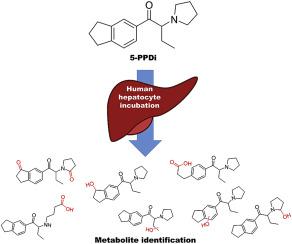Journal of Pharmaceutical Analysis ( IF 6.1 ) Pub Date : 2019-12-28 , DOI: 10.1016/j.jpha.2019.12.006 David Fabregat-Safont 1 , Marie Mardal 2, 3 , Juan V Sancho 1 , Félix Hernández 1 , Kristian Linnet 2 , María Ibáñez 1

|
Synthetic cathinones are new psychoactive substances that represent a health risk worldwide. For most of the 130 reported compounds, information about toxicology and/or metabolism is not available, which hampers their detection (and subsequent medical treatment) in intoxication cases. The principles of forensic analytical chemistry and the use of powerful analytical techniques are indispensable for stablishing the most appropriate biomarkers for these substances. Human metabolic fate of synthetic cathinones can be assessed by the analysis of urine and blood obtained from authentic consumers; however, this type of samples is limited and difficult to access. In this work, the metabolic behaviour of three synthetic cathinones (4-CEC, 4-CPrC and 5-PPDi) and one amphetamine (3-FEA) has been evaluated by incubation with pooled human hepatocytes and metabolite identification has been performed by high-resolution mass spectrometry. This in vitro approach has previously shown its feasibility for obtaining excretory human metabolites. 4-CEC and 3-FEA were not metabolised, and for 4-CPrC only two minor metabolites were obtained. On the contrary, for the recently reported 5-PPDi, twelve phase I metabolites were elucidated. Up to our knowledge, this is the first metabolic study of an indanyl-cathinone. Data reported in this paper will allow the detection of these synthetic stimulants in intoxication cases, and will facilitate future research on the metabolic behaviour of other indanyl-based cathinones.
中文翻译:

人体肝细胞孵育后,四种合成兴奋剂的代谢谱,包括新型茚满基-卡西酮5-PPDi。
合成的卡西酮是代表全世界健康风险的新型精神活性物质。对于所报告的130种化合物中的大多数,尚无有关毒理学和/或代谢的信息,这在中毒病例中妨碍了其检测(以及随后的医学治疗)。法医分析化学原理和强大的分析技术的使用对于建立最适合这些物质的生物标记物是必不可少的。合成卡西酮的人类新陈代谢命运可以通过分析从真实消费者那里获得的尿液和血液进行评估。但是,这种类型的样本数量有限且难以获取。在这项工作中,三种合成卡西酮(4-CEC,4-CPrC和5-PPDi)和一种苯丙胺(3-FEA)已通过与人类肝细胞合并培养进行了评估,并且代谢物鉴定已通过高分辨率质谱进行。这体外方法先前已显示出其获得排泄性人类代谢物的可行性。4-CEC和3-FEA不被代谢,而对于4-CPrC,仅获得了两个次要代谢物。相反,对于最近报道的5-PPDi,阐明了十二种I相代谢产物。据我们所知,这是茚满基-卡西酮的首次代谢研究。本文报道的数据将允许在中毒病例中检测到这些合成兴奋剂,并将有助于未来对其他基于茚满基的卡西酮的代谢行为的研究。











































 京公网安备 11010802027423号
京公网安备 11010802027423号